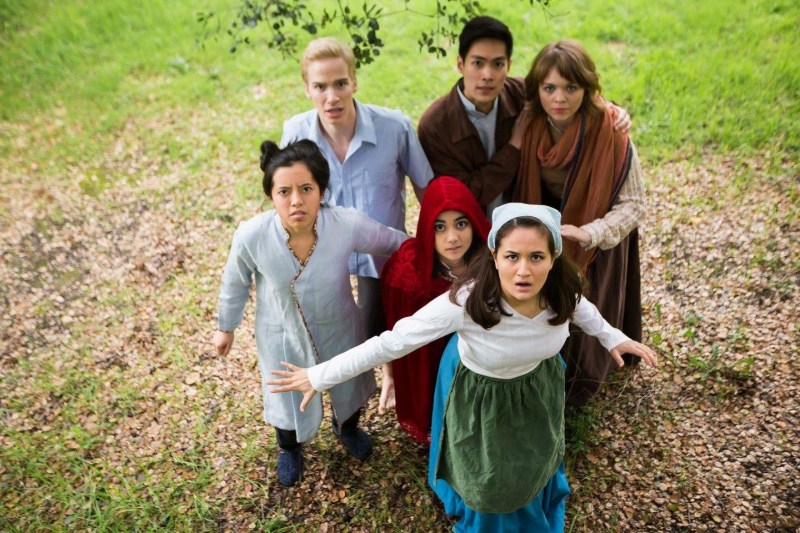The Asian American Theater Project’s (AATP) production of “Into the Woods” opens this Friday, January 22. In between rehearsals and production meetings, I was able to sit down and talk to director Ariana Johnson (‘17) about what makes this performance of “Into the Woods” so special.
The Stanford Daily (TSD): Why is it important that the Asian American Theater Project (AATP) is putting on “Into the Woods”?
Ariana Johnson (AJ): Mirae Lee (Producer, ’17) and I were attracted to the musical for its structure. Different fairytales coming together to create a larger, cohesive story allows us to explore what it looks like today for different people to come together and form new communities. One of the ways we are doing this is by setting each fairytale within a different Asian culture. We want to show how we celebrate culture in solidarity with people different from us, both at Stanford and in a globalized world, all the while exploring the innate humanity that unites us.
TSD: How does your vision connect to what AATP does?
AJ: Part of AATP’s mission is to increase representation within the arts, particularly on stage. So I’m really proud that we have the opportunity to showcase a lot of artists who might not be traditionally cast for these roles and designs that you usually would not see.
TSD: Designing costumes to represent so many different cultures must have been a challenge.
AJ: There were a lot of difficult questions with costumes like “What is the boundary between representation and appropriation?” Quito Tsui (Costume Designer, ’18) worked to show diversity in a generally homogeneously considered title of Asian. Ultimately, we wanted to explore what it means to be Asian-American, taking certain elements from different cultures, but thinking mainly about our generation that may not belong to just one culture.
TSD: Does this mean that as the fairytales start to cross over, the costumes also start to blend?
AJ: Certain motifs get passed around, but we generally kept characters as they were. We did not want to send a message that when you combine people, you lose culture. Rather, we explored how individuals can come together while still having solidarity with each other.
TSD: What makes this production special?
AJ: This production really focuses on the story: how it’s applicable for our generation and for students at Stanford. As part of that, we moved away from big production value and spectacular theatrical effects generally accompanying this production, focusing more on the characters, their relationships, and the music. At the end, we want “Into the Woods” to be a journey that allows the audience to ask questions about race, how people relate, and ultimately the meaning of life.
TSD: What do you want the audience to take away when they leave the Dinkelspiel Auditorium?
AJ: One of the best known songs of “Into the Woods” is “No One Is Alone,” which shows how people are always there for you. To me, the flip side is also true: It’s a responsibility to be there for others as well. A powerful message related to this is that as you have the power and freedom to be the author of your own story — you can actively work with the people around you to create a community.
TSD: Speaking of “No One Is Alone,” who helped you the most throughout the production process?
AJ: My closest collaborator has been Mirae. We have been working together since we proposed this project last spring. But I’ve also been impressed by the way the cast and the staff have come together to form a family out of this, stepping up to help across departments and supporting each other both in both official capacities and as individuals.
TSD: What was your favorite part of the production?
AJ: This will sound really cliché, but I really loved seeing people grow through this. We have a number of people in the cast that have never been in a show before and people in tech who are doing completely new jobs or getting involved in theater for the first time. I love watching the moment when they realize how powerful theater can be and what a great vehicle for change it can be.
TSD: What was the most challenging part?
AJ: Creating the rehearsal schedule for a 16-person cast and 16-person orchestra was its own challenge. In something less schedule related, this show is traditionally done in a very silly way, relying on overacted caricatures of classic characters. It was demanding to find ways to keep the show realistic. With a more naturalistic approach, I wanted to expose important truths that get brushed over in the comedic nature of the show and show a mirror to reality for the audience.
TSD: What will “Into the Woods” ultimately do for the audience?
AJ: The overall conclusion of our performance is that we’re presenting questions for the audience. We’re not always giving answers, but we the cast and the crew spent time considering issues of identities and beliefs. Now it’s a chance for the audience to re-examine their assumptions: We hope the audience will engage in dialogue, not to reach a consensus, but to create a safe space to start a conversation.
“Into the Woods” performs Jan. 22-23 at Dinkelspiel Auditorium. For tickets, visit tinyurl.com/IntoTheWoodsAATP.
